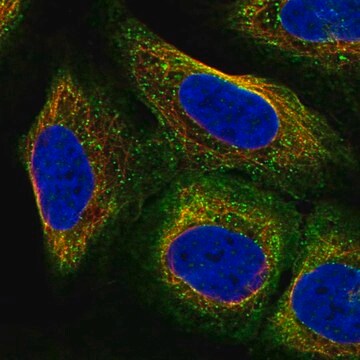MABF3203
Anti-Tissue Factor/CD142 Antibody, clone HTF-1
Sinônimo(s):
Coagulation factor III, HTF1-7B8, TF, Thromboplastin
About This Item
Produtos recomendados
fonte biológica
mouse
Nível de qualidade
forma do anticorpo
purified antibody
tipo de produto de anticorpo
primary antibodies
clone
HTF-1, monoclonal
peso molecular
calculated mol wt 33 kDa
observed mol wt ~42-48 kDa
purificado por
using protein G
reatividade de espécies
human, bovine
embalagem
antibody small pack of 100
técnica(s)
ELISA: suitable
dot blot: suitable
flow cytometry: suitable
immunohistochemistry: suitable
inhibition assay: suitable
western blot: suitable
Isotipo
IgG1κ
sequência de epítopo
Unknown
nº de adesão de ID de proteína
nº de adesão UniProt
temperatura de armazenamento
-10 to -25°C
Informações sobre genes
human ... F3(2152)
Especificidade
Imunogênio
Aplicação
Tissue factor: Identification and characterization of cell types in human placentae. (Faulk, W.P., C.A. Labarrere, and S.D. Carson. (1990). Blood 76:86-96).
Immunofluorescent studies of tissue factor on U87MG cells: Evidence for non-uniform distribution. Carson, S.D., and S.J. Pirruccello. (1993). Blood Coagulation and Fibrinolysis 4:911-920).
Flow Cytometry
Tissue factor antigen and activity are not expressed on the surface of intact cells isolated from an acute promyelocytic leukemia patient. (Carson, S.D., S.J. Pirruccello, and W.D. Haire. (1990). Thrombos. Res. 59:159-170).
Immunohistochemistry
Participation of cell-mediated immunity in the deposition of fibrin in glomerulonephritis. (Neale, T.J., P.G. Tipping, S.D. Carson, and S.R. Holdsworth. (1988). Lancet, No. 8606, 2:421-424).
Tissue factor antigen in senile plaques of Alzheimer′s disease. (McComb, R.D., K.A. Miller, and S.D. Carson. (1991). Am. J. Path. 139:491-494).
Immunoaffinity purification of the tissue factor protein
An inhibitory monoclonal antibody against human tissue factor. (Carson, S.D., S.E. Ross, R. Bach, and A. Guha. (1987). Blood 70:490-493).
Evaluated by Western Blotting in A-431cell lysate.
Western Blotting Analysis: A 1:500 dilution of this antibody detected Tissue Factor/CD142 in A-431 cell lysate.
Tested Applications
ELISA Analysis: A representative lot detected Tissue Factor/CD142 in ELISA applications (Carson, S.D., et al. (1987). Blood. 70(2):490-3).
Western Blotting Analysis: A representative lot detected Tissue Factor/CD142 in Western Blotting applications (Carson, S.D., et al. (1987). Blood. 70(2):490-3). .
Dot Blot: A representative lot detected Tissue Factor/CD142 in Dot Blot applications (Carson, S.D., et al. (1987). Blood. 70(2):490-3).
Inhibition Assay: A representative lot detected Tissue Factor/CD142 in Inhibition applications (Carson, S.D., et al. (1987). Blood. 70(2):490-3).
Note: Actual optimal working dilutions must be determined by end user as specimens, and experimental conditions may vary with the end user.
Descrição-alvo
forma física
Reconstituição
Armazenamento e estabilidade
Outras notas
Exoneração de responsabilidade
Não está encontrando o produto certo?
Experimente o nosso Ferramenta de seleção de produtos.
Código de classe de armazenamento
12 - Non Combustible Liquids
Classe de risco de água (WGK)
WGK 2
Ponto de fulgor (°F)
Not applicable
Ponto de fulgor (°C)
Not applicable
Certificados de análise (COA)
Busque Certificados de análise (COA) digitando o Número do Lote do produto. Os números de lote e remessa podem ser encontrados no rótulo de um produto após a palavra “Lot” ou “Batch”.
Já possui este produto?
Encontre a documentação dos produtos que você adquiriu recentemente na biblioteca de documentos.
Nossa equipe de cientistas tem experiência em todas as áreas de pesquisa, incluindo Life Sciences, ciência de materiais, síntese química, cromatografia, química analítica e muitas outras.
Entre em contato com a assistência técnica







